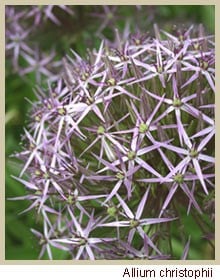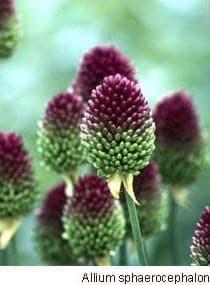Alliums
There was a time when alliums were thought of only as vegetables (the group includes onions, leeks, shallots, chives and garlic), however the taller varieties with their huge rounded flowerheads are now one of the stars of the architectural plant world. Their stiff lollipop-shaped heads are perfect for off-setting sharp vertical leaves, tall poker-like flowers and the softer forms of flowing grasses, while their rich (usually purple) colour is beautiful either contrasting with hot reds, yellows and oranges or intermingling with the cooler tones of lilac, blue and white.
Alliums grow from 30cm up to 200cm with flowerheads from tiny pompoms to huge spheres of star-shaped flowers. The smaller, dinky varieties are excellent for rock gardens and the front of the border. Chives and garlic are well-suited to these sites and have the added bonus that their smell confuses aphids and other pesky insects so they search elsewhere for food. Plant these pungent plants around other vegetables and vulnerable plants such as roses to stave off attacks.

Alliums not only look good when in full bloom, as the spent flowerheads can be left to dry on the plant to provide architectural interest through autumn and winter. The globes will look stunning when covered by a hard frost - particularly those of Allium christophii. Alternatively, cut the flowers fresh and mix with iris and the thousand-flowered Gypsophilla for an eye-catching indoor arrangement.
Growing guide
Alliums like a hot, sunny site with good, rich soil. They can survive in a more sandy site, but to get the really sumptuous big heads, they will need to be well mulched. They are bulbous perennials, so can be either planted as bulbs in the autumn, planting up to 15cm deep or as potted plants throughout the year. The plants will soon establish themselves and usually flower the following season. Being bulbous also means that plants produce little offsets around the original, so will eventually form big clumps.
Propagation

During late summer any over-large clumps can be divided into smaller sections and replanted. Also new plants can be propagated from the offset bulbils (newly formed, little bulbs). Most bulbils are formed underground around the original bulb. These can be carefully broken off and planted in gritty compost about 1cm deep. Allium sphaerocephalon is a variety which produces aerial bulbils – these grow from out of the flowerhead. These can be planted in the same way as described above.
A happy allium will self-seed freely. If you want to decide where your new plants will appear (rather than leaving it to chance and chaos), you can collect the seeds from the plant before they fall. Remove the heads (and stalks) as soon as they turn brown. Put into a paper bag ready to collect the seeds as the pods open. Either sow the seeds directly into the soil where you want them to grow, or keep in the bag in a cool place until the following spring. Most alliums germinate in 12 weeks, but it can take up to a year, so patience is required.
Pest alert
As a rule alliums are healthy plants, although in a humid spell they can suffer from downy mildew as well as white rot. Being a member of the onion family they sometimes get attacked by onion fly – a common early symptom is yellowing foliage, while white maggots eat away at the roots causing the plant to suddenly collapse. This pest is very difficult to treat because the maggots are right down in the soil and even in the bulb itself. To control onion fly, dig up any affected plants so that the maggots are not left to pupate, turn into adults and produce more grubs.
Variety guide
The best known flowering allium is probably A. giganteum, which can grow up to 1.8m, producing purplish-pink spherical heads 10-15cm across. Despite their size they almost never require staking. Plant it at the back of a border as a focal point, it looks stunning planted along with another giant – the grass Stipa gigantean. Another option is the 80cm tall variety ‘Globemaster’ which is ideal for growing between shrubs in a sunny border where its huge 15cm wide spherical flowerheads add a seasonal splash of deep violet. Perhaps though the loveliest of the clan is Allium sphaerocephalon which bears extraordinary two-tone maroon and green flowerheads. It looks beautiful planted in a border with grasses or other globe-headed flowers, such as Echinops and Eryngium.
Allium hollandicum ‘Purple Sensation’ will grow to 1m tall and its flowers, which are a rich rosy-purple, is lovely for a sunny border. It looks particularly superb planted alongside feathery leaved fennel. A. karataviense reaches just 25cm tall, making it perfect for the rock garden. The flowers are large and pale pink with unusual, dark-red-edged leaves. Even smaller at 20cm tall, the variety ‘Ivory Queen’ is another possibility for a rock garden or for growing in a pot on the patio - thriving in dry soil in a sunny spot.
Crocus tip
The foliage of many of the taller alliums will already be dying back by the time the flowers appear, but if planted among perennials that have attractive foliage (such as the herbaceous geraniums), these tatty leaves can be hidden.
Container plants
Although alliums like a well-drained soil in a sunny spot, if grown in containers they must not be allowed to dry out during the spring otherwise the flower buds can fail to open.






